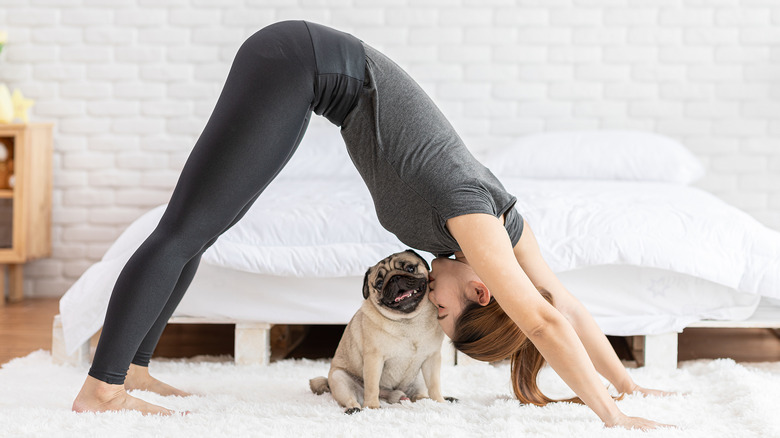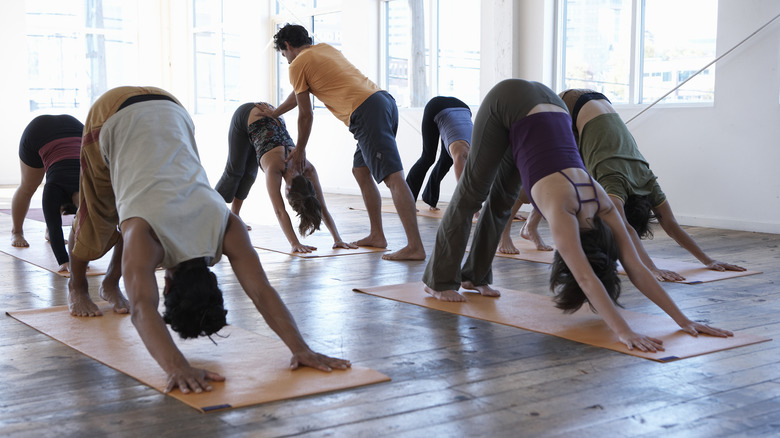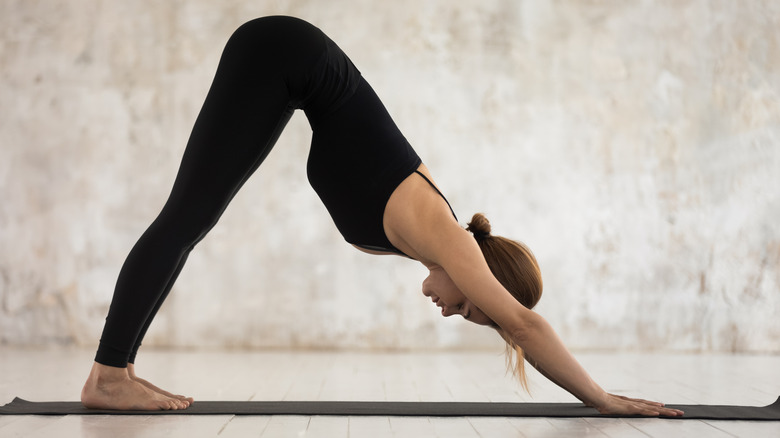Impressive Benefits Of Practicing Downward Dog
It's no secret that there are a number of benefits from participating in a regular yoga practice. In addition to being a low-impact means of exercise, Healthline explains that there are numerous ways that practicing yoga can benefit you. These benefits include improved flexibility, increased strength, a boost in mental health and mood, and even improved immunity and cardiovascular performance. Yoga is also said to be a practice that can help to reduce anxiety and calm the mind.
While there are a number of different yoga practices, there are some common poses and movements that are used across all methods. In fact, some yoga postures are recommended for individuals who are involved in any type of athletics, according to Ace Fitness. Poses like the downward facing dog, also known as downward dog or down dog pose, are often recommended to improve an athlete's balance, build strength, and boost mental focus.
Though it's recommended for all athletes for the effects it can have in sports, there are several benefits that can be gained from routinely practicing the downward dog position.
What is the downward dog?
The downward dog position is a beginner yoga pose that is used with a great deal of versatility. Often used as a warm-up, cool-down, transitional, and rest pose, the downward dog focuses on using core strength to help the body create a triangular shape (via Boston University).
To engage in downward dog pose, the individual typically begins on their hands and knees with a neutral spine and their wrists under their shoulders, as explained by Women's Health. The person then tucks the toes under, lifts the abdomen, and extends the knees to straighten the legs. The arms maintain their position on the floor or mat with the head between the upper arms.
It's important to avoid locking the knees, allowing for a slight bend to avoid overstretching the muscles. When fully engaged correctly, the downward dog pose uses the upper back, shoulders, biceps, triceps, glutes, hamstrings, calves, and core muscles, providing you with a near-full body stretch. However, there are also some additional benefits of the downward dog pose that you may not know.
Benefits of downward dog
Certain benefits of downward dog, such as improved flexibility and increased muscle strength, are expected. However, many individuals may not realize that the downward dog pose can also help improve your health in other ways. The pose requires you to have your head positioned lower than your heart. In yoga, any pose that creates this position (heart over head) is considered an inversion. Inversions help to improve your blood circulation. They can also help to improve other bodily functions, such as your daily bathroom breaks, or even alleviate pressure from congested sinuses, according to Daily Burn.
Doing downward dog pose daily can also help you to build bone density, Self explains. Since the exercise helps to build upper body strength, it can be a gentle way of preserving and improving bone density. As a partial inversion pose, down dog also can help you to elongate your spine (via Boston University). Other benefits can include having a more radiant complexion or "glow" in your appearance, due to the increased blood flow to your face, neck, and chest as a result of the pose (via Daily Burn).
If you're looking for a versatile stretching pose that will not only improve your flexibility but provide you with a host of additional benefits, you might consider starting each morning off with a daily dose of downward dog.



